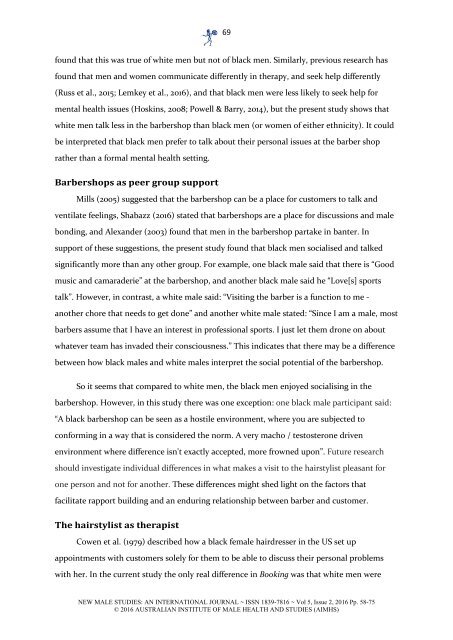IS HEALTH?
article-5
article-5
You also want an ePaper? Increase the reach of your titles
YUMPU automatically turns print PDFs into web optimized ePapers that Google loves.
69<br />
found that this was true of white men but not of black men. Similarly, previous research has<br />
found that men and women communicate differently in therapy, and seek help differently<br />
(Russ et al., 2015; Lemkey et al., 2016), and that black men were less likely to seek help for<br />
mental health issues (Hoskins, 2008; Powell & Barry, 2014), but the present study shows that<br />
white men talk less in the barbershop than black men (or women of either ethnicity). It could<br />
be interpreted that black men prefer to talk about their personal issues at the barber shop<br />
rather than a formal mental health setting.<br />
Barbershops as peer group support<br />
Mills (2005) suggested that the barbershop can be a place for customers to talk and<br />
ventilate feelings, Shabazz (2016) stated that barbershops are a place for discussions and male<br />
bonding, and Alexander (2003) found that men in the barbershop partake in banter. In<br />
support of these suggestions, the present study found that black men socialised and talked<br />
significantly more than any other group. For example, one black male said that there is “Good<br />
music and camaraderie” at the barbershop, and another black male said he “Love[s] sports<br />
talk”. However, in contrast, a white male said: “Visiting the barber is a function to me -<br />
another chore that needs to get done” and another white male stated: “Since I am a male, most<br />
barbers assume that I have an interest in professional sports. I just let them drone on about<br />
whatever team has invaded their consciousness.” This indicates that there may be a difference<br />
between how black males and white males interpret the social potential of the barbershop.<br />
So it seems that compared to white men, the black men enjoyed socialising in the<br />
barbershop. However, in this study there was one exception: one black male participant said:<br />
“A black barbershop can be seen as a hostile environment, where you are subjected to<br />
conforming in a way that is considered the norm. A very macho / testosterone driven<br />
environment where difference isn't exactly accepted, more frowned upon”. Future research<br />
should investigate individual differences in what makes a visit to the hairstylist pleasant for<br />
one person and not for another. These differences might shed light on the factors that<br />
facilitate rapport building and an enduring relationship between barber and customer.<br />
The hairstylist as therapist<br />
Cowen et al. (1979) described how a black female hairdresser in the US set up<br />
appointments with customers solely for them to be able to discuss their personal problems<br />
with her. In the current study the only real difference in Booking was that white men were<br />
NEW MALE STUDIES: AN INTERNATIONAL JOURNAL ~ <strong>IS</strong>SN 1839-7816 ~ Vol 5, Issue 2, 2016 Pp. 58-75<br />
© 2016 AUSTRALIAN INSTITUTE OF MALE <strong>HEALTH</strong> AND STUDIES (AIMHS)


